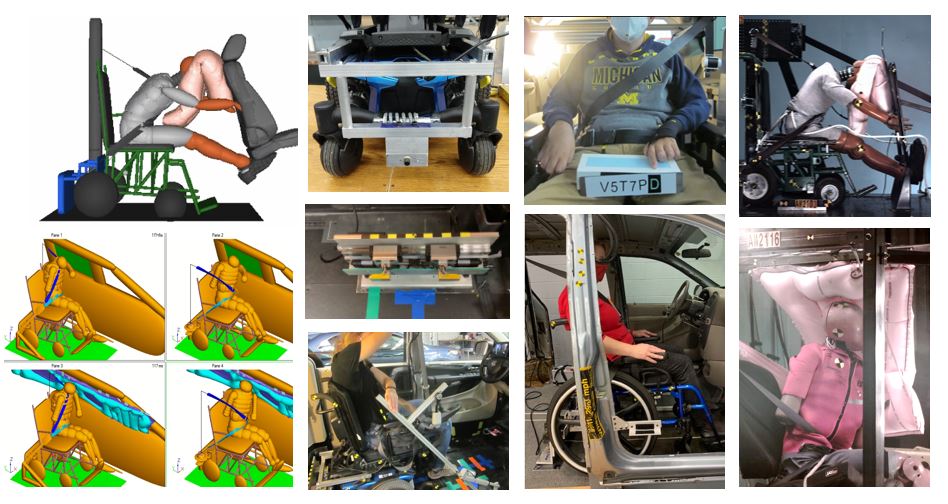Sponsor: National Highway Traffic Safety Administration
Dates: October 2019 to November 2021
Researchers: Kathleen D. Klinich, Jingwen Hu, Miriam Manary, Kyle Boyle, Nichole Orton
Overview

This project developed an automated WTORS (AWTORS) that could be safely and independently used in an AV by someone using a wheelchair as vehicle seating (Klinich et al. 2021, under review). The project used past research, computational modeling, prototype construction, volunteer evaluation, and dynamic testing to demonstrate feasibility.
Computational modeling was used to optimize placement of the wheelchair station, locate the wheelchair anchorages relative to the occupant, optimize belt anchor locations, and determine airbag characteristics for front and side impacts. Frontal simulations showed improved injury measures with a SCaRAB airbag, particularly with suboptimal belt geometry. Side impact simulations showed adequate protection in nearside crashes with standard curtain airbags and outboard shoulder belt location. However, changes to belt geometry were insufficient to keep the occupant within the wheelchair during farside impacts, leading to design of a Center Airbag To Contain Humans (CATCH). Computer models of power and manual wheelchairs were developed and used to choose restraint and geometry parameters for sled testing.
The concept for securing the wheelchair to the vehicle used hardware meeting specifications of the UDIG that have been included in RESNA and ISO standards. Vehicle anchorages meeting the specifications were constructed, as were attachment designs for a commercial manual and power wheelchair. The occupant restraint portion of the AWTORS include an automatic seatbelt donning mechanism based on a past UMTRI prototype, but with geometric improvements.
Volunteer testing was performed with eight wheelchair users. Using the two study wheelchairs equipped with UDIG anchors, the study evaluated the usability of four wheelchair seating stations with different geometries, each with two different belt conditions. Data included videos of ingress and egress, scans of volunteer posture, and questionnaires to document the time spent docking the wheelchair and donning the seatbelt, belt fit, comfort, and potential usability issues. Average time for entry, docking, and donning was less than 2 minutes in all conditions. For three-quarters of trials, participants would recommend use of the docking and donning systems. The preparation of test fixtures for volunteer testing identified challenges in implementing optimal geometry defined through simulations.
Ten frontal sled tests were performed to demonstrate differences with belt geometry and airbag presence, as well as to check the durability of UDIG anchors and attachments. Eight farside impacts were run to evaluate different versions of the CATCH bag, as well as to check durability of UDIG attachments in side impact.
Publications
Klinich KD, Manary MA, Boyle KJ, Orton NR, Hu J (2022) Development of an Automated Wheelchair Tiedown and Occupant Restraint System. UMTRI 2021-02. University of Michigan Transportation Research Institute. Note: This report includes the same technical content as DOT HS 813 275. However, the title differs from the DOT report; it emphasizes that the “Wheelchair Tiedowns” and “Occupant Restraint Systems” are both separate, important components needed to travel safely while seated in a wheelchair.
Public presentation on project
Hu J, Klinich KD, Manary MA, Orton NR, Boyle K, Wang Y, Fischer K, Smith A & Adler A (2022) Improving protection systems for wheelchair-seated occupants in vehicle side impacts, Traffic Injury Prevention.
Klinich KD, Manary MA, Orton NR, Boyle KB, Hu J (2022) A Literature Review of Wheelchair Transportation Safety Relevant to Automated Vehicles. International Journal of Environmental Research and Public Health. 19(3):1633.
Klinich KD, Boyle, K, Manary MA, Orton NR, Wang Y, Hu J (2023) Optimizing Frontal Occupant Protection Systems for Occupants Seated in Wheelchairs. Accident Analysis and Prevention. 92:107238.
Videos
Comparison of model and test using optimal belt geometry identified through simulations.
Comparison of model and test using a typical geometry where shoulder belt is anchored to the vehicle C-pillar, leading to a shoulder belt position further outboard than optimal.
Comparison of model and test using a typical geometry where shoulder belt is anchored to the vehicle C-pillar, together with a SCARAB airbag originally designed for rear seat passengers. The SCARAB helps compensate for suboptimal geometry.
Demonstration of the Center Airbag To Contain Humans (CATCH) designed to prevent a person from falling out of their wheelchair during a farside crash.
